climate control FORD F-59 2019 Owners Manual
[x] Cancel search | Manufacturer: FORD, Model Year: 2019, Model line: F-59, Model: FORD F-59 2019Pages: 176, PDF Size: 9.98 MB
Page 29 of 176
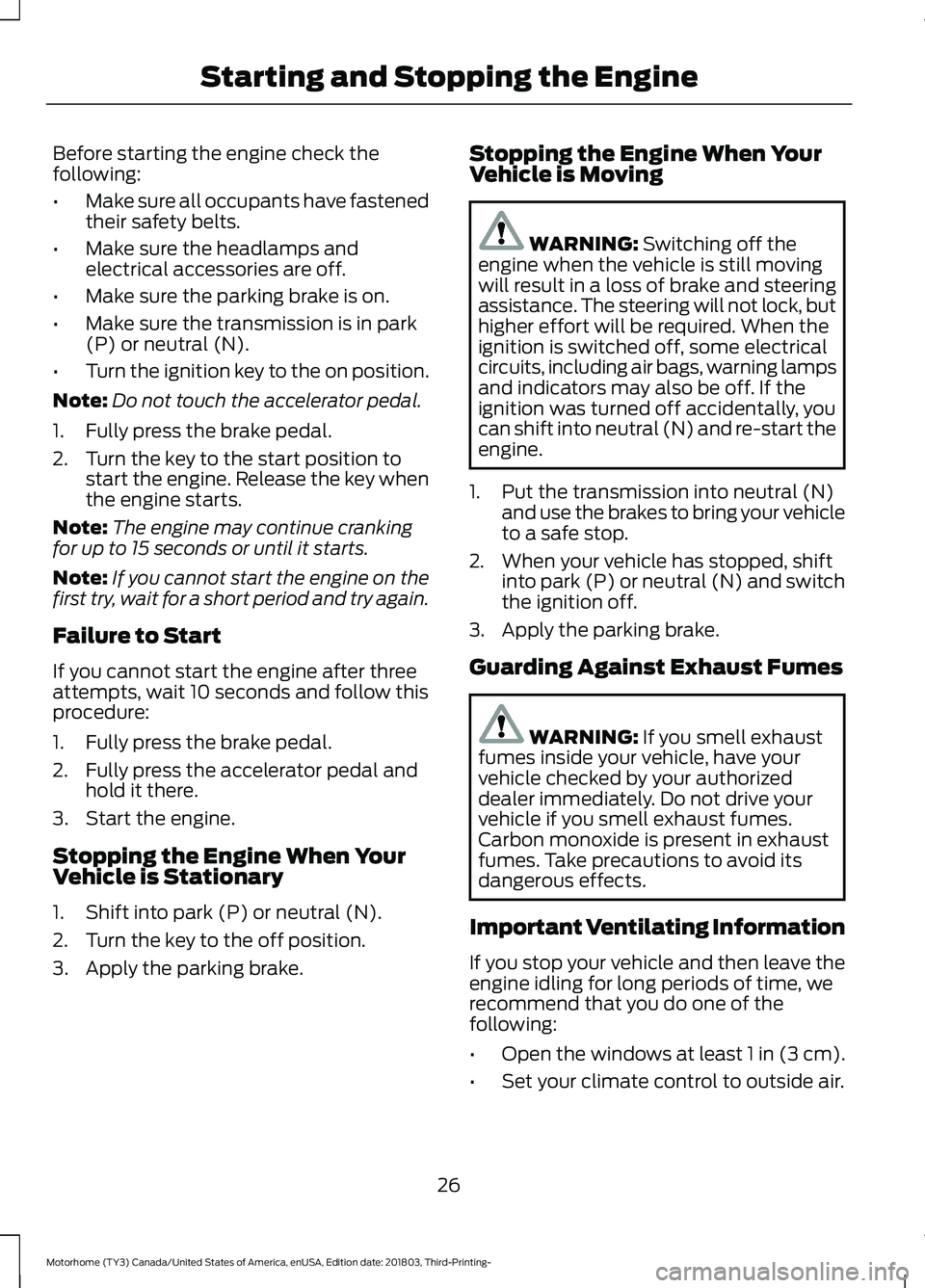
Before starting the engine check thefollowing:
•Make sure all occupants have fastenedtheir safety belts.
•Make sure the headlamps andelectrical accessories are off.
•Make sure the parking brake is on.
•Make sure the transmission is in park(P) or neutral (N).
•Turn the ignition key to the on position.
Note:Do not touch the accelerator pedal.
1.Fully press the brake pedal.
2.Turn the key to the start position tostart the engine. Release the key whenthe engine starts.
Note:The engine may continue crankingfor up to 15 seconds or until it starts.
Note:If you cannot start the engine on thefirst try, wait for a short period and try again.
Failure to Start
If you cannot start the engine after threeattempts, wait 10 seconds and follow thisprocedure:
1.Fully press the brake pedal.
2.Fully press the accelerator pedal andhold it there.
3.Start the engine.
Stopping the Engine When YourVehicle is Stationary
1.Shift into park (P) or neutral (N).
2.Turn the key to the off position.
3.Apply the parking brake.
Stopping the Engine When YourVehicle is Moving
WARNING: Switching off theengine when the vehicle is still movingwill result in a loss of brake and steeringassistance. The steering will not lock, buthigher effort will be required. When theignition is switched off, some electricalcircuits, including air bags, warning lampsand indicators may also be off. If theignition was turned off accidentally, youcan shift into neutral (N) and re-start theengine.
1.Put the transmission into neutral (N)and use the brakes to bring your vehicleto a safe stop.
2.When your vehicle has stopped, shiftinto park (P) or neutral (N) and switchthe ignition off.
3.Apply the parking brake.
Guarding Against Exhaust Fumes
WARNING: If you smell exhaustfumes inside your vehicle, have yourvehicle checked by your authorizeddealer immediately. Do not drive yourvehicle if you smell exhaust fumes.Carbon monoxide is present in exhaustfumes. Take precautions to avoid itsdangerous effects.
Important Ventilating Information
If you stop your vehicle and then leave theengine idling for long periods of time, werecommend that you do one of thefollowing:
•Open the windows at least 1 in (3 cm).
•Set your climate control to outside air.
26
Motorhome (TY3) Canada/United States of America, enUSA, Edition date: 201803, Third-Printing-Starting and Stopping the Engine
Page 30 of 176
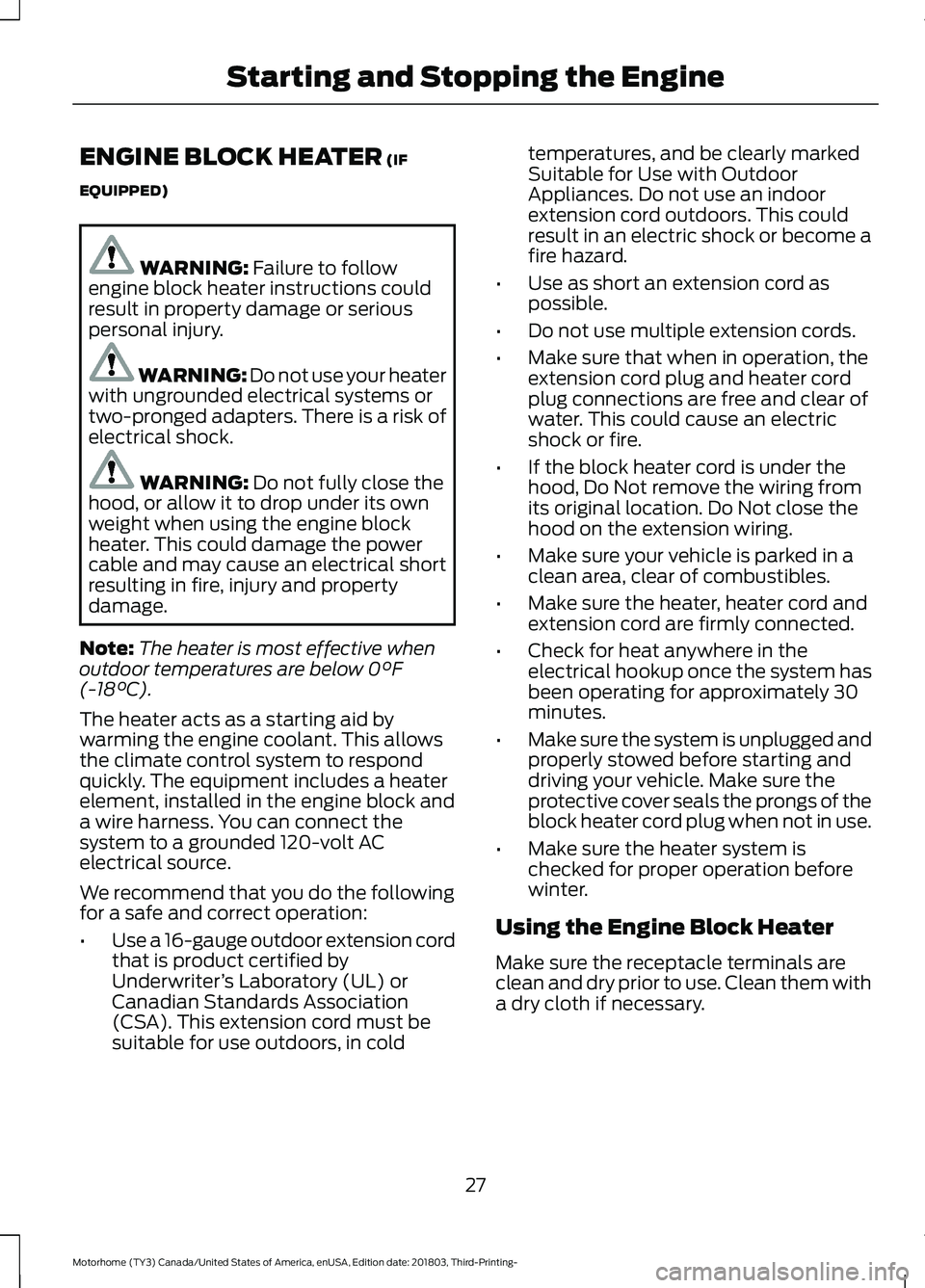
ENGINE BLOCK HEATER (IF
EQUIPPED)
WARNING: Failure to followengine block heater instructions couldresult in property damage or seriouspersonal injury.
WARNING: Do not use your heaterwith ungrounded electrical systems ortwo-pronged adapters. There is a risk ofelectrical shock.
WARNING: Do not fully close thehood, or allow it to drop under its ownweight when using the engine blockheater. This could damage the powercable and may cause an electrical shortresulting in fire, injury and propertydamage.
Note:The heater is most effective whenoutdoor temperatures are below 0°F(-18°C).
The heater acts as a starting aid bywarming the engine coolant. This allowsthe climate control system to respondquickly. The equipment includes a heaterelement, installed in the engine block anda wire harness. You can connect thesystem to a grounded 120-volt ACelectrical source.
We recommend that you do the followingfor a safe and correct operation:
•Use a 16-gauge outdoor extension cordthat is product certified byUnderwriter’s Laboratory (UL) orCanadian Standards Association(CSA). This extension cord must besuitable for use outdoors, in cold
temperatures, and be clearly markedSuitable for Use with OutdoorAppliances. Do not use an indoorextension cord outdoors. This couldresult in an electric shock or become afire hazard.
•Use as short an extension cord aspossible.
•Do not use multiple extension cords.
•Make sure that when in operation, theextension cord plug and heater cordplug connections are free and clear ofwater. This could cause an electricshock or fire.
•If the block heater cord is under thehood, Do Not remove the wiring fromits original location. Do Not close thehood on the extension wiring.
•Make sure your vehicle is parked in aclean area, clear of combustibles.
•Make sure the heater, heater cord andextension cord are firmly connected.
•Check for heat anywhere in theelectrical hookup once the system hasbeen operating for approximately 30minutes.
•Make sure the system is unplugged andproperly stowed before starting anddriving your vehicle. Make sure theprotective cover seals the prongs of theblock heater cord plug when not in use.
•Make sure the heater system ischecked for proper operation beforewinter.
Using the Engine Block Heater
Make sure the receptacle terminals areclean and dry prior to use. Clean them witha dry cloth if necessary.
27
Motorhome (TY3) Canada/United States of America, enUSA, Edition date: 201803, Third-Printing-Starting and Stopping the Engine
Page 114 of 176
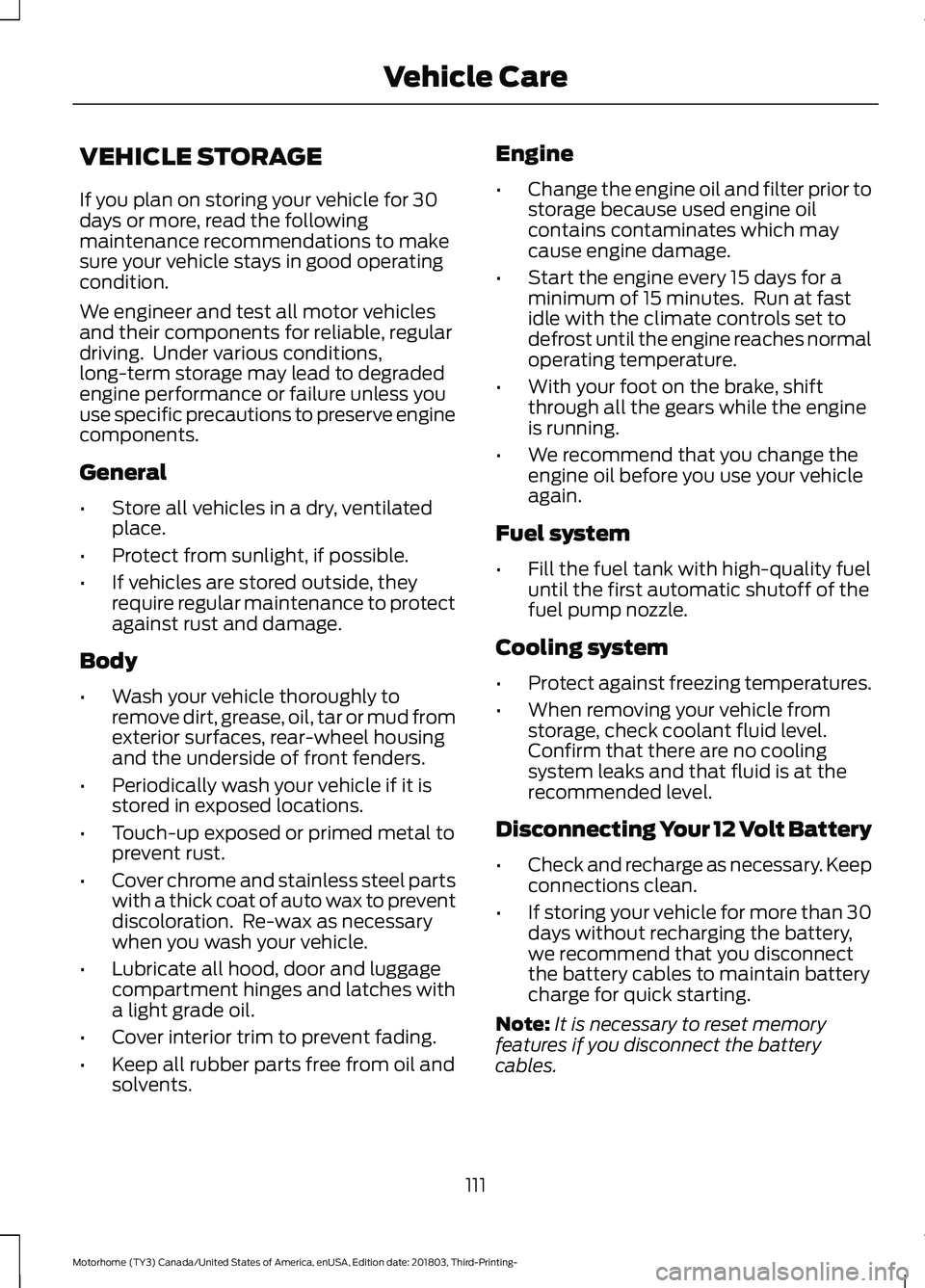
VEHICLE STORAGE
If you plan on storing your vehicle for 30days or more, read the followingmaintenance recommendations to makesure your vehicle stays in good operatingcondition.
We engineer and test all motor vehiclesand their components for reliable, regulardriving. Under various conditions,long-term storage may lead to degradedengine performance or failure unless youuse specific precautions to preserve enginecomponents.
General
•Store all vehicles in a dry, ventilatedplace.
•Protect from sunlight, if possible.
•If vehicles are stored outside, theyrequire regular maintenance to protectagainst rust and damage.
Body
•Wash your vehicle thoroughly toremove dirt, grease, oil, tar or mud fromexterior surfaces, rear-wheel housingand the underside of front fenders.
•Periodically wash your vehicle if it isstored in exposed locations.
•Touch-up exposed or primed metal toprevent rust.
•Cover chrome and stainless steel partswith a thick coat of auto wax to preventdiscoloration. Re-wax as necessarywhen you wash your vehicle.
•Lubricate all hood, door and luggagecompartment hinges and latches witha light grade oil.
•Cover interior trim to prevent fading.
•Keep all rubber parts free from oil andsolvents.
Engine
•Change the engine oil and filter prior tostorage because used engine oilcontains contaminates which maycause engine damage.
•Start the engine every 15 days for aminimum of 15 minutes. Run at fastidle with the climate controls set todefrost until the engine reaches normaloperating temperature.
•With your foot on the brake, shiftthrough all the gears while the engineis running.
•We recommend that you change theengine oil before you use your vehicleagain.
Fuel system
•Fill the fuel tank with high-quality fueluntil the first automatic shutoff of thefuel pump nozzle.
Cooling system
•Protect against freezing temperatures.
•When removing your vehicle fromstorage, check coolant fluid level.Confirm that there are no coolingsystem leaks and that fluid is at therecommended level.
Disconnecting Your 12 Volt Battery
•Check and recharge as necessary. Keepconnections clean.
•If storing your vehicle for more than 30days without recharging the battery,we recommend that you disconnectthe battery cables to maintain batterycharge for quick starting.
Note:It is necessary to reset memoryfeatures if you disconnect the batterycables.
111
Motorhome (TY3) Canada/United States of America, enUSA, Edition date: 201803, Third-Printing-Vehicle Care
Page 116 of 176
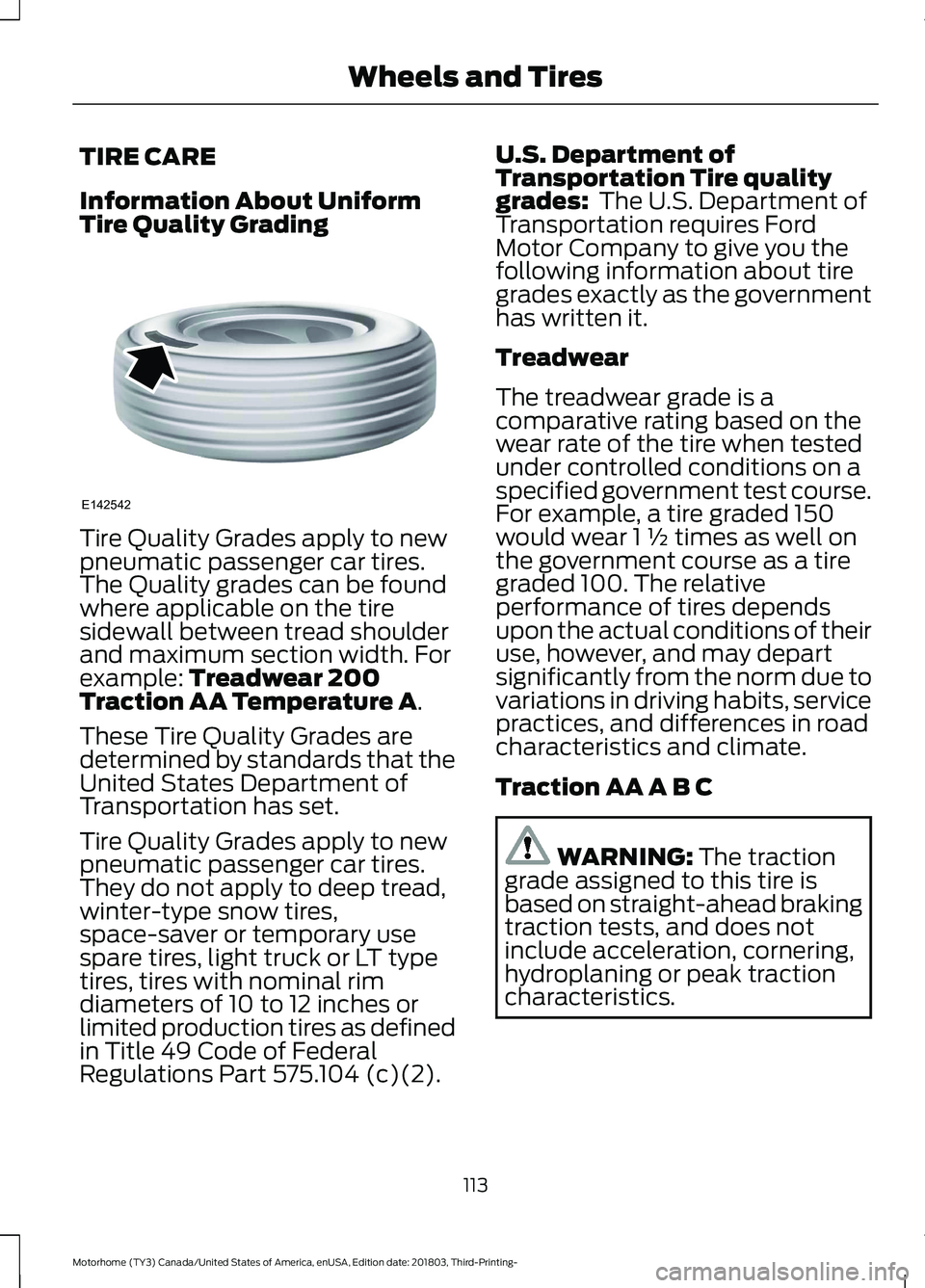
TIRE CARE
Information About UniformTire Quality Grading
Tire Quality Grades apply to newpneumatic passenger car tires.The Quality grades can be foundwhere applicable on the tiresidewall between tread shoulderand maximum section width. Forexample: Treadwear 200Traction AA Temperature A.
These Tire Quality Grades aredetermined by standards that theUnited States Department ofTransportation has set.
Tire Quality Grades apply to newpneumatic passenger car tires.They do not apply to deep tread,winter-type snow tires,space-saver or temporary usespare tires, light truck or LT typetires, tires with nominal rimdiameters of 10 to 12 inches orlimited production tires as definedin Title 49 Code of FederalRegulations Part 575.104 (c)(2).
U.S. Department ofTransportation Tire qualitygrades: The U.S. Department ofTransportation requires FordMotor Company to give you thefollowing information about tiregrades exactly as the governmenthas written it.
Treadwear
The treadwear grade is acomparative rating based on thewear rate of the tire when testedunder controlled conditions on aspecified government test course.For example, a tire graded 150would wear 1 ½ times as well onthe government course as a tiregraded 100. The relativeperformance of tires dependsupon the actual conditions of their
use, however, and may departsignificantly from the norm due tovariations in driving habits, servicepractices, and differences in roadcharacteristics and climate.
Traction AA A B C
WARNING: The tractiongrade assigned to this tire isbased on straight-ahead brakingtraction tests, and does notinclude acceleration, cornering,hydroplaning or peak tractioncharacteristics.
113
Motorhome (TY3) Canada/United States of America, enUSA, Edition date: 201803, Third-Printing-Wheels and TiresE142542
Page 132 of 176
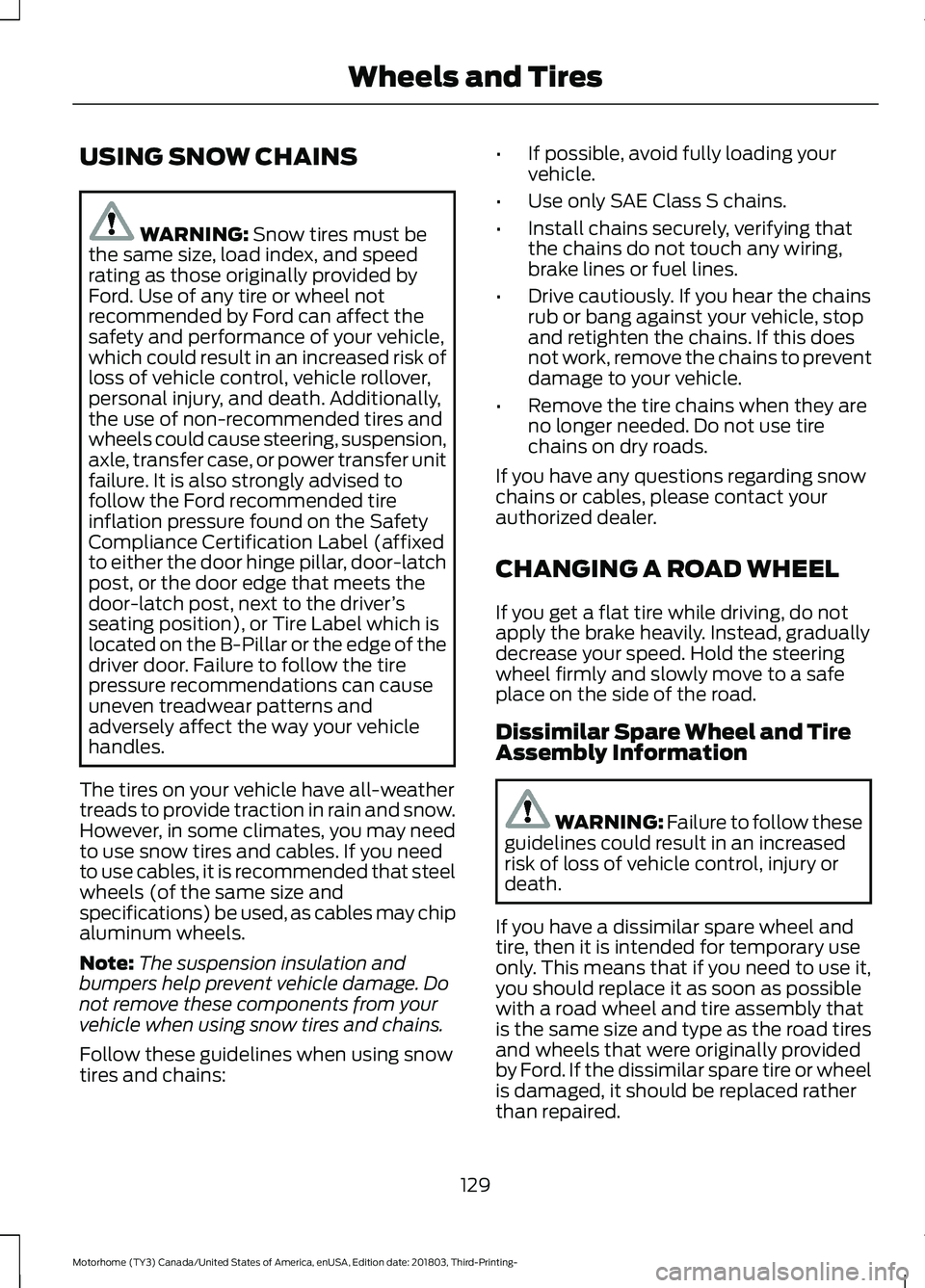
USING SNOW CHAINS
WARNING: Snow tires must bethe same size, load index, and speedrating as those originally provided byFord. Use of any tire or wheel notrecommended by Ford can affect thesafety and performance of your vehicle,which could result in an increased risk ofloss of vehicle control, vehicle rollover,personal injury, and death. Additionally,the use of non-recommended tires andwheels could cause steering, suspension,axle, transfer case, or power transfer unitfailure. It is also strongly advised tofollow the Ford recommended tireinflation pressure found on the SafetyCompliance Certification Label (affixedto either the door hinge pillar, door-latchpost, or the door edge that meets thedoor-latch post, next to the driver’sseating position), or Tire Label which islocated on the B-Pillar or the edge of thedriver door. Failure to follow the tirepressure recommendations can causeuneven treadwear patterns andadversely affect the way your vehiclehandles.
The tires on your vehicle have all-weathertreads to provide traction in rain and snow.However, in some climates, you may needto use snow tires and cables. If you needto use cables, it is recommended that steelwheels (of the same size andspecifications) be used, as cables may chipaluminum wheels.
Note:The suspension insulation andbumpers help prevent vehicle damage. Donot remove these components from yourvehicle when using snow tires and chains.
Follow these guidelines when using snowtires and chains:
•If possible, avoid fully loading yourvehicle.
•Use only SAE Class S chains.
•Install chains securely, verifying thatthe chains do not touch any wiring,brake lines or fuel lines.
•Drive cautiously. If you hear the chainsrub or bang against your vehicle, stopand retighten the chains. If this doesnot work, remove the chains to preventdamage to your vehicle.
•Remove the tire chains when they areno longer needed. Do not use tirechains on dry roads.
If you have any questions regarding snowchains or cables, please contact yourauthorized dealer.
CHANGING A ROAD WHEEL
If you get a flat tire while driving, do notapply the brake heavily. Instead, graduallydecrease your speed. Hold the steeringwheel firmly and slowly move to a safeplace on the side of the road.
Dissimilar Spare Wheel and TireAssembly Information
WARNING: Failure to follow theseguidelines could result in an increasedrisk of loss of vehicle control, injury ordeath.
If you have a dissimilar spare wheel andtire, then it is intended for temporary useonly. This means that if you need to use it,you should replace it as soon as possiblewith a road wheel and tire assembly thatis the same size and type as the road tiresand wheels that were originally providedby Ford. If the dissimilar spare tire or wheelis damaged, it should be replaced ratherthan repaired.
129
Motorhome (TY3) Canada/United States of America, enUSA, Edition date: 201803, Third-Printing-Wheels and Tires
Page 172 of 176
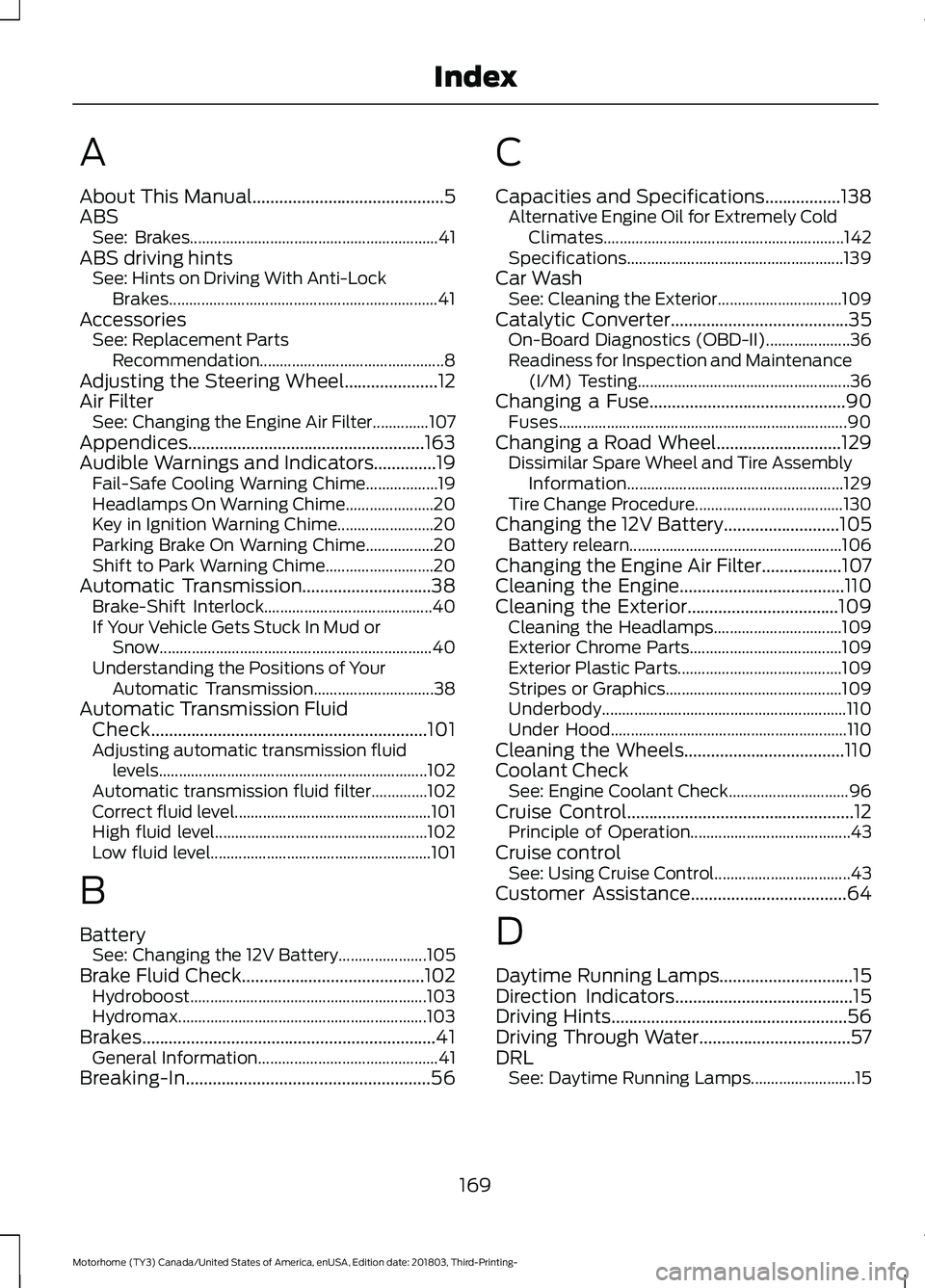
A
About This Manual...........................................5ABSSee: Brakes..............................................................41ABS driving hintsSee: Hints on Driving With Anti-LockBrakes...................................................................41AccessoriesSee: Replacement PartsRecommendation..............................................8Adjusting the Steering Wheel.....................12Air FilterSee: Changing the Engine Air Filter..............107Appendices.....................................................163Audible Warnings and Indicators..............19Fail-Safe Cooling Warning Chime..................19Headlamps On Warning Chime......................20Key in Ignition Warning Chime........................20Parking Brake On Warning Chime.................20Shift to Park Warning Chime...........................20Automatic Transmission.............................38Brake-Shift Interlock..........................................40If Your Vehicle Gets Stuck In Mud orSnow....................................................................40Understanding the Positions of YourAutomatic Transmission..............................38Automatic Transmission FluidCheck..............................................................101Adjusting automatic transmission fluidlevels...................................................................102Automatic transmission fluid filter..............102Correct fluid level.................................................101High fluid level.....................................................102Low fluid level.......................................................101
B
BatterySee: Changing the 12V Battery......................105Brake Fluid Check.........................................102Hydroboost...........................................................103Hydromax..............................................................103Brakes..................................................................41General Information.............................................41Breaking-In.......................................................56
C
Capacities and Specifications.................138Alternative Engine Oil for Extremely ColdClimates............................................................142Specifications......................................................139Car WashSee: Cleaning the Exterior...............................109Catalytic Converter........................................35On-Board Diagnostics (OBD-II).....................36Readiness for Inspection and Maintenance(I/M) Testing.....................................................36Changing a Fuse............................................90Fuses........................................................................90Changing a Road Wheel............................129Dissimilar Spare Wheel and Tire AssemblyInformation......................................................129Tire Change Procedure.....................................130Changing the 12V Battery..........................105Battery relearn.....................................................106Changing the Engine Air Filter..................107Cleaning the Engine.....................................110Cleaning the Exterior..................................109Cleaning the Headlamps................................109Exterior Chrome Parts......................................109Exterior Plastic Parts.........................................109Stripes or Graphics............................................109Underbody.............................................................110Under Hood...........................................................110Cleaning the Wheels....................................110Coolant CheckSee: Engine Coolant Check..............................96Cruise Control...................................................12Principle of Operation........................................43Cruise controlSee: Using Cruise Control..................................43Customer Assistance...................................64
D
Daytime Running Lamps..............................15Direction Indicators........................................15Driving Hints.....................................................56Driving Through Water..................................57DRLSee: Daytime Running Lamps..........................15
169
Motorhome (TY3) Canada/United States of America, enUSA, Edition date: 201803, Third-Printing-Index
Page 173 of 176
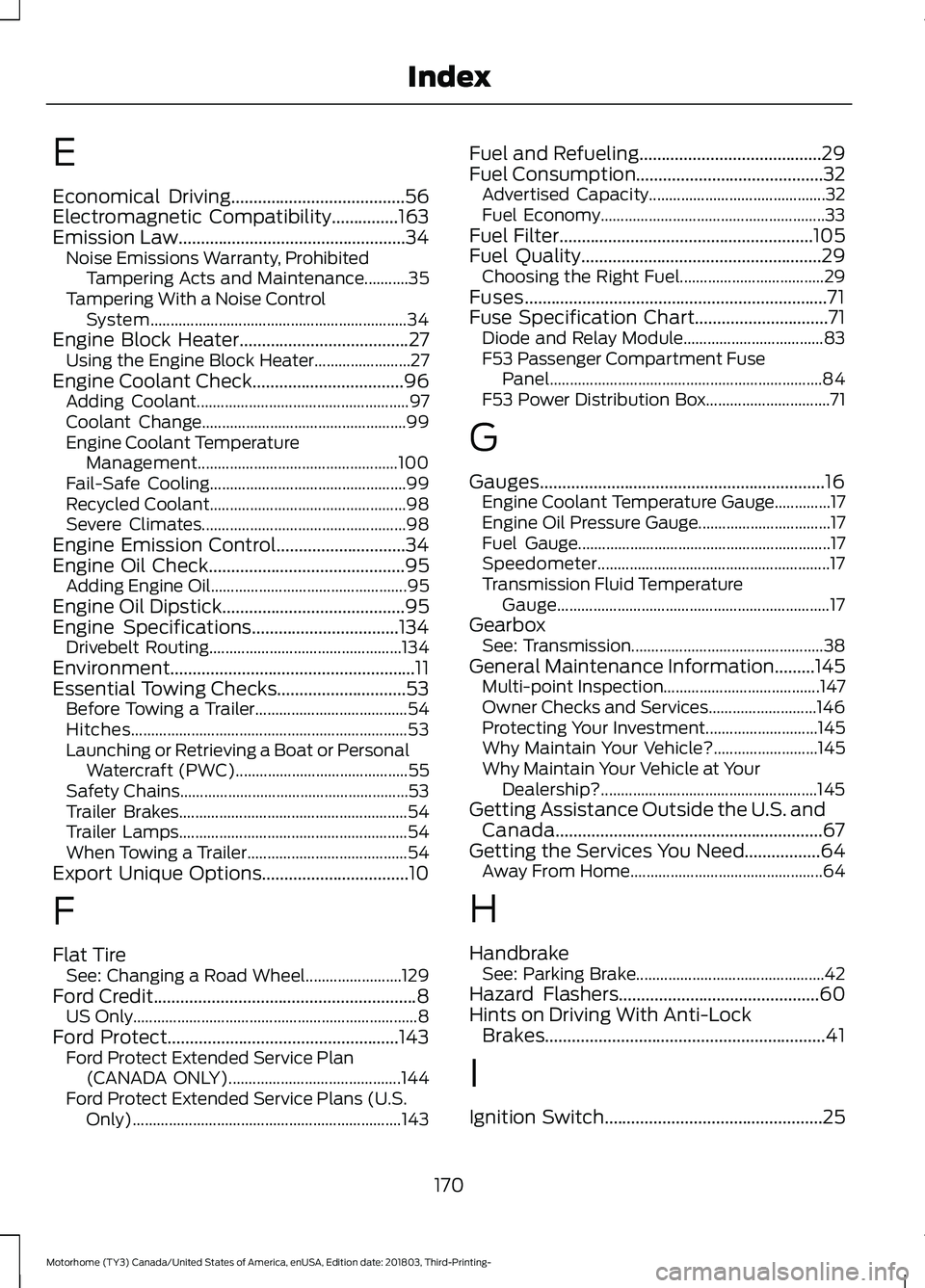
E
Economical Driving.......................................56Electromagnetic Compatibility...............163Emission Law...................................................34Noise Emissions Warranty, ProhibitedTampering Acts and Maintenance...........35Tampering With a Noise ControlSystem................................................................34Engine Block Heater......................................27Using the Engine Block Heater........................27Engine Coolant Check..................................96Adding Coolant.....................................................97Coolant Change...................................................99Engine Coolant TemperatureManagement..................................................100Fail-Safe Cooling.................................................99Recycled Coolant.................................................98Severe Climates...................................................98Engine Emission Control.............................34Engine Oil Check............................................95Adding Engine Oil.................................................95Engine Oil Dipstick.........................................95Engine Specifications.................................134Drivebelt Routing................................................134Environment.......................................................11Essential Towing Checks.............................53Before Towing a Trailer......................................54Hitches.....................................................................53Launching or Retrieving a Boat or PersonalWatercraft (PWC)...........................................55Safety Chains.........................................................53Trailer Brakes.........................................................54Trailer Lamps.........................................................54When Towing a Trailer........................................54Export Unique Options.................................10
F
Flat TireSee: Changing a Road Wheel........................129Ford Credit...........................................................8US Only.......................................................................8Ford Protect....................................................143Ford Protect Extended Service Plan(CANADA ONLY)...........................................144Ford Protect Extended Service Plans (U.S.Only)...................................................................143
Fuel and Refueling.........................................29Fuel Consumption..........................................32Advertised Capacity............................................32Fuel Economy........................................................33Fuel Filter.........................................................105Fuel Quality......................................................29Choosing the Right Fuel....................................29Fuses....................................................................71Fuse Specification Chart..............................71Diode and Relay Module...................................83F53 Passenger Compartment FusePanel....................................................................84F53 Power Distribution Box...............................71
G
Gauges................................................................16Engine Coolant Temperature Gauge..............17Engine Oil Pressure Gauge.................................17Fuel Gauge...............................................................17Speedometer..........................................................17Transmission Fluid TemperatureGauge....................................................................17GearboxSee: Transmission................................................38General Maintenance Information.........145Multi-point Inspection.......................................147Owner Checks and Services...........................146Protecting Your Investment............................145Why Maintain Your Vehicle?..........................145Why Maintain Your Vehicle at YourDealership?......................................................145Getting Assistance Outside the U.S. andCanada............................................................67Getting the Services You Need.................64Away From Home................................................64
H
HandbrakeSee: Parking Brake...............................................42Hazard Flashers.............................................60Hints on Driving With Anti-LockBrakes...............................................................41
I
Ignition Switch.................................................25
170
Motorhome (TY3) Canada/United States of America, enUSA, Edition date: 201803, Third-Printing-Index